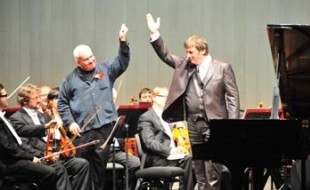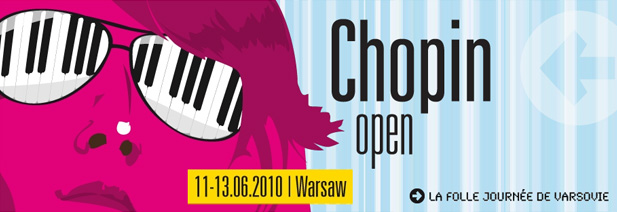La Folle Journée

La Folle Journée is a series of music events, implemented since 1995. René Martin, the initiator and organizer of the festival, as well as the initiator of other festivals and numerous concerts of classical music worldwide, is also the founder the of CREA — Centre for Artistic Research and Creation in Nantes.
| foto. Dominik Skurzak |
The idea of the festival is to popularize classical music and bring it to the widest possible audience, to inspire them to get started with classical music, open new horizons for the reception of art and discover new fascinations.
CHARACTERISTICS OF THE FESTIVAL:
- Individual selection of the program: a lot of concerts at one time and place for a few days;
- Symbolic ticket prices: PLN 5-7-10;
- Affordable length of the concert: 45 minutes;
- The free atmosphere of the event: no evening dresses, crazy atmosphere of a feast of music;
- The highest artistic level: the presence of prominent, world-renowned virtuosi.
For many years the International Festival “La Folle Journée” has been carried out successfully in many countries: from France (since 1995), through Spain (in Bilbao since 2002), Japan (Tokyo and 4 other cities), to Brazil (in Rio since 2007). It has a recognized position in the cultural life of their local communities and has great popularity. From the beginning of the existence of the Festival, Sinfonia Varsovia takes part in all its worldwide editions.
La Folle Journée is the biggest music festival in the world as far as the number of concerts, number of performing artists and the audience density is concerned. This year in France only, almost 200,000 tickets were sold and 460 concerts were performed by 1800 artists. And in Tokyo - over one million tickets!
Additionally to the concerts, during the Festival take also place several educational programs, interesting workshops for teachers and students, and special concerts for children and parents.
In 2010 all the editions of La Folle Journée Festival all over the world gathered about 400 thousand spectators who listened to 950 concerts (270 concerts in France, 60 in Bilbao, 300 in Japan, 48 in Brazil, and 120 concerts in Poland - attended by 26,000 listeners).
PROGRAMME 2011 LES TITANS
Focusing on the European post-Romanticism, the festival "La Folle Journée Festival de Varsovie / Crazy Days of Music 2011 Les Titans" spans a century of music: from 1850 to 1950, from Brahms to Richard Strauss and the Viennese School.
Brahms, the last great composer of the Romantic Period whose artistic achievements originated from the rich German tradition, had a significant influence on many artists – from composers of the second half of the nineteenth century, to Arnold Schönberg of the early twentieth century.
Simultaneously, under the influence of Liszt's late works, and in the climate of Wagner who preached the idea of "music of the future", a strong artistic trend developed, whose goal was to profoundly renew the language of music. This trend attracted Austrian natives Anton Bruckner (staunch opponent of Brahms), Gustav Mahler, Hugo Wolf and Alexander von Zemlinsky, as well as German native Richard Strauss (whose long career beganduring the fall of the Austro-Hungarian Empire and ended after the World War II.)
Viennese School, founded in the early twentieth century by Arnold Schoenberg and uniting his students Alban Berg and Anton Webern, was a synthesis of these two conflicting trends. It drew inspiration from Brahms, as well as from Wagner, Mahler and Strauss, while developing its own aesthetics, which influenced German composers such as Paul Hindemith and Hanns Eisler.
On the other side of the border, in Poland, there was a composer, whose works entered the main repertoire of Viennese School. At the same time, he sought to compose music that was typically Polish. At the turn of the century, Karol Szymanowski appeared as a poet of Polish national music, composing Slavic songs, and restoring the treasures of Polish folk music.
THE FESTIVALS LA FOLLE JOURNÉE 2011 ALL OVER THE WORLD:
- 28-30 January 2011 La Folle Journée in the Region Pays de la Loire (154 concerts, 11 cities, 58,000 tickets)
- 2-6 February 2011 La Folle Journée in Nantes (305 concerts; 1800 artists, 135,000 tickets)
- 3-6 March 2011 La Folle Journée in Bilbao
- 30 April-8 May 2011 La Folle Journée in Japan, in 5 cities, including:
- 29-30 April La Folle Journée in Biwako
- 1-4 May La Folle Journée in Kanazawa
- 3-5 May La Folle Journée in Tokyo
- 5-7 May La Folle Journée in Tosu
- 6-8 May La Folle Journée in Niigata
- October 2011 La Folle Journée in Rio de Janeiro (to be confirmed)
- 29 September-2 October 2011 La Folle Journée in Warsaw
La Folle Journée in 2012 will focus on the Russian music since 1870 until today.
2010 Festival edition – La Folle Journée de Varsovie 2010 Chopin Open - go to the website www.chopinopen.pl








































